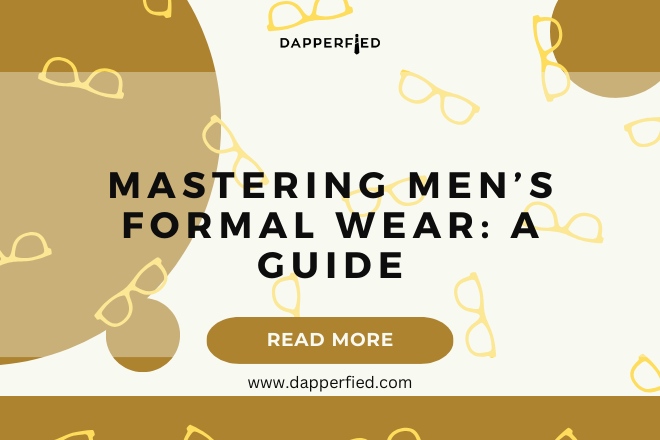
Men's Style
Mastering Men’s Suiting: Exploring Classic & Modern Styles
Men’s suiting is an essential part of a man’s wardrobe. Whether it’s for a job interview, a wedding, or a formal event, wearing a well-fitted suit can make a lasting impression. A suit not only enhances a man’s appearance but also boosts his confidence and professionalism. It is a symbol of sophistication and style, and it communicates to others that the wearer takes pride in his appearance and pays attention to detail.
In job interviews, wearing a suit shows that you are serious about the position and that you respect the company’s dress code. It gives you an edge over other candidates and makes you stand out as someone who is professional and put-together. Similarly, at weddings, wearing a suit shows respect for the couple and the occasion. It demonstrates that you have made an effort to dress appropriately and that you value the importance of the event.
Key Takeaways
- Men’s suiting is important for making a good impression in professional and formal settings.
- When selecting a suit, consider factors such as fit, fabric, and style.
- Classic and modern suit styles both have their own unique features and benefits.
- A well-tailored suit is essential for achieving a polished and professional look.
- Investing in a quality suit and properly maintaining it can save money in the long run and ensure it lasts for years to come.
Suit Selection Tips: How to Choose the Perfect Suit
When selecting a suit, there are several factors to consider. First, think about the occasion. Is it a formal event or a more casual gathering? This will determine the level of formality required for your suit. Next, consider your body type. Different suit styles flatter different body types, so it’s important to choose one that complements your physique. Finally, think about your personal style. Do you prefer classic or modern suits? This will help guide your choice of fabric, color, and pattern.
When it comes to fabric, wool is the most popular choice for suits due to its durability and breathability. It is suitable for both warm and cold weather and has a luxurious feel. Other options include cotton, linen, and synthetic blends. The color of your suit should be chosen based on your skin tone and personal preference. Classic colors like navy blue, charcoal gray, and black are versatile and timeless. Patterns such as pinstripes and checks can add visual interest to your suit, but be mindful of their appropriateness for the occasion.
Men’s Suiting Styles: Classic vs. Modern
Classic and modern suit styles each have their own unique characteristics and appeal. Classic suits are timeless and traditional, with a focus on clean lines and a tailored fit. They are characterized by single-breasted jackets with notch lapels and straight-leg trousers. Classic suits are versatile and can be worn for both formal and semi-formal occasions.
On the other hand, modern suits are more fashion-forward and contemporary. They often feature slim-fit jackets with narrow lapels and tapered trousers. Modern suits are designed to be more fitted and streamlined, giving the wearer a sleek and stylish look. They are popular among younger men who want to make a fashion statement.
When choosing between classic and modern suit styles, it’s important to consider your body type and personal style. Classic suits are more forgiving for different body types, while modern suits tend to be more fitted and may not be suitable for everyone. Additionally, classic suits are timeless and can be worn for years without going out of style, while modern suits may become outdated more quickly.
The Tailored Suit Guide: Understanding the Importance of Fit
| Metrics | Values |
|---|---|
| Number of pages | 15 |
| Number of sections | 4 |
| Number of images | 8 |
| Number of diagrams | 3 |
| Number of tips | 10 |
| Number of examples | 5 |
| Number of case studies | 2 |
| Number of testimonials | 3 |
The fit of a suit is perhaps the most important factor to consider when it comes to looking sharp and put-together. A well-fitted suit enhances your physique and gives you a polished appearance. It should accentuate your best features while minimizing any flaws.
To get the right fit, it’s important to take accurate measurements of your body. This includes measuring your chest, waist, hips, shoulders, sleeve length, and inseam. If you’re unsure how to do this yourself, it’s best to visit a professional tailor who can take precise measurements for you.
Once you have your measurements, it’s time to find a good tailor who can make the necessary alterations to your suit. A skilled tailor can make adjustments to the jacket and trousers to ensure a perfect fit. They can take in or let out the waist, shorten or lengthen the sleeves, and adjust the hem of the trousers. It’s worth investing in a good tailor who can make your suit look like it was made just for you.
Suit Buying Tips: How to Invest in Quality
Investing in a quality suit is essential if you want it to last for years and maintain its shape and appearance. While it may be tempting to go for a cheap suit, it’s important to remember that you get what you pay for. A cheap suit is likely to be made from inferior materials and will not fit as well as a higher-quality suit.
When shopping for a suit, look for one that is made from high-quality fabrics such as wool or a wool blend. These fabrics are durable and will hold their shape over time. Pay attention to the construction of the suit as well. Look for details such as reinforced stitching, quality buttons, and a well-constructed lining.
It’s also important to consider the brand when buying a suit. Established brands with a reputation for quality are more likely to produce suits that are well-made and long-lasting. Do some research and read reviews before making a purchase.
While investing in a quality suit may require a larger upfront cost, it will save you money in the long run as you won’t have to replace it as frequently. A well-made suit will also make you look and feel more confident, which is priceless.
Men’s Formal Wear: Understanding the Dress Code


Different occasions call for different levels of formality, and it’s important to dress appropriately for each dress code. Understanding the dress code will ensure that you are dressed correctly and won’t feel out of place.
The most formal dress code is black tie, which is typically reserved for evening events. For black tie, a tuxedo is required. This includes a black dinner jacket with satin lapels, a white dress shirt, a black bow tie, black trousers with a satin stripe, and black patent leather shoes.
Business formal is a dress code commonly seen in professional settings such as business meetings and conferences. It requires a suit in a conservative color such as navy blue or charcoal gray, a dress shirt, a tie, and dress shoes. A pocket square and cufflinks can add a touch of elegance to the outfit.
Business casual is a more relaxed dress code that allows for some flexibility. It typically includes dress pants or chinos, a button-down shirt or polo shirt, and dress shoes or loafers. A blazer or sport coat can be added for a more polished look.
Casual dress codes allow for even more freedom in terms of what you can wear. Jeans, t-shirts, and sneakers are acceptable, but it’s still important to look put-together and presentable. Avoid wearing anything too casual or sloppy.
The Power of Accessories: Elevating Your Suiting Game
Accessories play a crucial role in men’s suiting as they can elevate your outfit and add personality to your look. The right accessories can make a simple suit stand out and make a statement.
One of the most important accessories for men’s suiting is the tie. A well-chosen tie can add color and pattern to your outfit and tie everything together. When choosing a tie, consider the color and pattern of your suit and shirt. Opt for a tie that complements these colors rather than one that clashes with them.
Pocket squares are another accessory that can add flair to your suit. They are small pieces of fabric that are folded and placed in the breast pocket of your jacket. Pocket squares come in various colors and patterns, allowing you to experiment with different looks. They can be matched to your tie or shirt, or they can be a contrasting color or pattern.
Other accessories to consider include cufflinks, tie bars, and lapel pins. These small details can make a big difference in your overall look. Choose accessories that are appropriate for the occasion and that reflect your personal style.
The Art of Layering: Dressing for Different Occasions
Layering is an important technique in men’s suiting as it allows you to adapt your outfit to different occasions and weather conditions. By adding or removing layers, you can create different looks and stay comfortable throughout the day.

For formal occasions, layering can be achieved by adding a waistcoat or a vest to your suit. This adds an extra layer of sophistication and can be worn with or without a jacket. A waistcoat can also help to hide any imperfections in the fit of your suit.
In colder weather, layering becomes even more important. You can add a cardigan or a sweater over your dress shirt for added warmth and style. A scarf can also be added for extra insulation and to add visual interest to your outfit.
When layering, it’s important to consider the colors and patterns of each layer. Opt for complementary colors and patterns that work well together. Avoid wearing too many layers as this can make you look bulky and unkempt.
Suit Maintenance: Keeping Your Suit in Top Shape
Proper suit maintenance is essential if you want your suit to last for years and maintain its shape and appearance. A well-maintained suit will always look sharp and put-together, while a neglected suit will quickly lose its appeal.
To keep your suit in top shape, it’s important to clean it regularly. This includes dry cleaning or spot cleaning as needed. Follow the care instructions on the label and take your suit to a professional cleaner who specializes in suits.
When storing your suit, hang it on a sturdy wooden hanger to maintain its shape. Avoid using wire hangers as they can cause the shoulders to stretch and lose their shape. Cover your suit with a breathable garment bag to protect it from dust and moths.
It’s also important to steam or press your suit before wearing it to remove any wrinkles or creases. Invest in a good quality steamer or iron and learn how to use it properly. If you’re unsure, take your suit to a professional cleaner who can steam or press it for you.
Mastering Men’s Suiting for Every Occasion
In conclusion, men’s suiting is an important aspect of a man’s wardrobe. Wearing a well-fitted suit can make a lasting impression and boost your confidence and professionalism. When selecting a suit, consider the occasion, your body type, and personal style. Choose the right fabric, color, and pattern to suit your needs.
Classic and modern suit styles each have their own unique appeal, so choose one that suits your body type and personal style. Invest in a well-fitted suit and find a good tailor who can make the necessary alterations. Understand the dress code for different occasions and dress appropriately.
Accessories play a crucial role in men’s suiting, so choose the right tie, pocket square, cufflinks, and lapel pins to elevate your outfit. Layering allows you to adapt your outfit to different occasions and weather conditions. Proper suit maintenance is essential if you want your suit to last for years.
By following these tips and investing in quality suits, you can master men’s suiting for every occasion and always look sharp and put-together. Experiment with different styles and accessories to find what works best for you.
If you’re a man who loves his watches, then you’ll definitely want to check out this article on buying a watch box for men. A watch box is not only a practical way to store and protect your timepieces, but it can also add a touch of elegance to your dressing area. With various styles and designs available, you can find the perfect watch box that suits your personal taste and complements your collection. So, whether you prefer a classic leather box or a modern display case, this article will guide you in making the right choice. Don’t miss out on this essential accessory for any watch enthusiast! For more information, click here.
FAQs
What are the different types of men’s suiting styles?
There are several types of men’s suiting styles, including classic, modern, slim fit, and athletic fit.
What is a classic men’s suit style?
A classic men’s suit style is a traditional style that features a single-breasted jacket with two or three buttons, notch lapels, and straight leg trousers.
What is a modern men’s suit style?
A modern men’s suit style is a more contemporary style that features a slimmer cut jacket with a shorter length, narrow lapels, and tapered trousers.
What is a slim fit men’s suit style?
A slim fit men’s suit style is a style that is designed to fit close to the body, with a narrow cut jacket and trousers that are tapered at the ankle.
What is an athletic fit men’s suit style?
An athletic fit men’s suit style is a style that is designed for men with a more muscular build, featuring a jacket with broader shoulders and a tapered waist, and trousers that are roomier in the thigh and seat.
What materials are commonly used in men’s suiting?
Common materials used in men’s suiting include wool, cotton, linen, and synthetic blends.
What colors are appropriate for men’s suiting?
Traditional colors for men’s suiting include black, navy, and gray, but other colors such as brown, tan, and even pastels can be appropriate depending on the occasion and personal style.


















